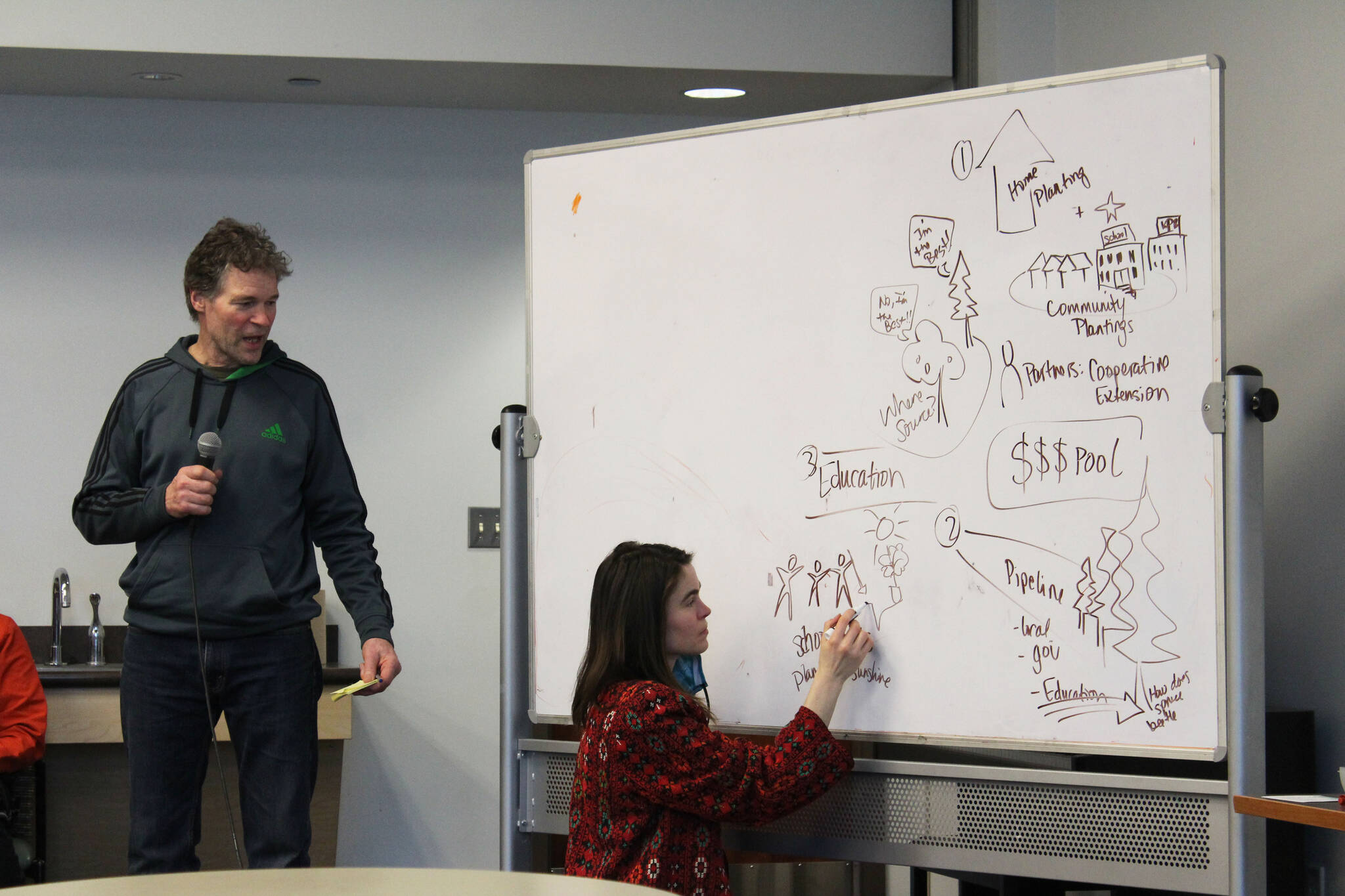To tackle climate change, members of Cook Inletkeeper are starting from the ground up.
On Thursday night, about 15 people involved in the local nonprofit huddled in small groups at the Soldotna Public Library, brainstorming how to get more trees to the central peninsula.
“Tonight, we’re really going to dive into trees,” forester Mitch Michaud called out to the room.
Now in its third year developing community-based actions to address climate change, the group is currently considering three different projects: a do-it-yourself program for home energy efficiency; “re-treeing” backyards; and capturing landfill methane emissions for energy.
Cook Inletkeeper debuted its “Drawdown: Book to Action Climate Series” in 2019, which brought members of the community together to create solutions to climate change. The series used the book “Drawdown: The Most Comprehensive Plan Ever Proposed to Reverse Global Warming” as a basic framework, with meetings structured around different chapters. The effort has so far resulted in two large-scale community projects.
The group piloted a decentralized composting program in 2019 that diverted more than 120,000 pounds of compostable materials away from landfills in two years. Cook Inletkeeper’s “Solarize the Kenai” launched in 2020 and made it more affordable for people to bring solar power to their homes in Seward, Soldotna and Homer.
Cook Inletkeeper’s community action efforts have since inspired a similar program in Homer, called Homer Drawdown. That group implemented its first solution last year, Cook Inletkeeper said, aimed at preserving peatland, which offsets carbon.
Now, Cook Inletkeeper is planning its next community solution.
Thursday’s meeting at the Soldotna library probed the possibilities of a “re-treeing” campaign, through which participants would aim to bring more trees to the central peninsula.
Cook Inletkeeper Regional Director Kaitlin Vadla praised the success of previous solutions that have been implemented and emphasized the role of community-level efforts to help solve the larger question of climate change.
“So many of the solutions don’t really care what your politics or your worldview are, they’re just really good for the community,” Vadla said. “As a bonus, they reverse global warming.”
Jim Renkert, who attended Thursday’s meeting remotely, is the coordinator for the Alaska Community Forestry Program under the Alaska Department of Natural Resources. He proposed several different ways to make the central peninsula more tree-friendly, such as through more partnerships with the Arbor Day Foundation.
“Community forest lands provide essential benefits we cannot live without,” Renkert said. “Healthy community forests help solve community problems.”
Also in attendance Thursday was Kenai Peninsula Borough Land Agent Dakota Truitt. She’s spearheading a new borough initiative to tackle the peninsula’s latest spruce bark beetle outbreak. As part of the proposed program, the borough would offer a timber sale of affected spruce and craft a forest management plan. The program also includes reforestation efforts, which attendees said could complement a re-treeing program.
The group broke out into smaller teams to brainstorm what re-treeing the central peninsula could look like. Some groups proposed more education about the local landscape, while others suggested working with the Kenai Peninsula Borough School District to plant trees with students.
“One of the things that we talked about was planning around schools but also incorporating some classwork, with an educator coming out in the late school season here and getting a bunch of kids involved in this whole program,” said Bruce Vadla, Kaitlin’s dad.
Cook Inletkeeper will hold a meeting on the third proposed community action — the capture of landfill methane — on April 21. A solution selection will take place during a different meeting on May 5. More information about all actions can be found on Cook Inletkeeper’s website at inletkeeper.org/localsolutions.
The Alaska Department of Commerce, Community and Economic Development has said that evidence of climate change in Alaska can be seen in warmer temperatures that result in thawing permafrost, thinning sea ice and increasing wildfires. The U.S. Fish and Wildlife surface estimates that annual available water on the western Kenai Peninsula has declined 55% and that the Harding Icefield has decreased 11% in surface area over the last 50 years.
Reach reporter Ashlyn O’Hara at ashlyn.ohara@peninsulaclarion.com.

